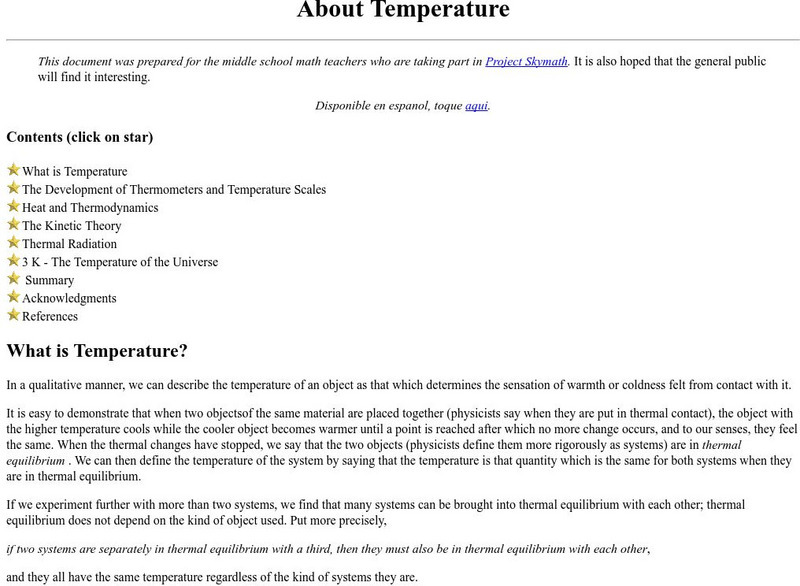Hi, what do you want to do?
Science Education Resource Center at Carleton College
Serc: Phenology Weekly
A long-term project lesson plan where students observe seasonal changes by recording observations and data of the weather conditions. Students will understand how to use a light meter, thermometer, anemometer, and rain gauge with this...
TeachEngineering
Teach Engineering: How Cold Can You Go?
Students explore materials engineering by modifying the material properties of water. Specifically, they use salt to lower the freezing point of water and test it by making ice cream. Using either a simple thermometer or a mechatronic...
TeachEngineering
Teach Engineering: Rooftop Gardens
Students explore whether rooftop gardens are a viable option for combating the urban heat island effect. Can rooftop gardens reduce the temperature inside and outside houses? Teams each design and construct two model buildings using foam...
Other
Massachusetts Department of Education: Sunlight Warms Earth's Surface
This unit contains a series of lessons that allow young scholars to explore the effect of sunlight on Earth's natural surfaces of sand, soil, rock, and water. In addition, students explore how the color and material of a surface affects...
Other
Ns Dept. Of Education: Blackline Masters, Math Essentials 11
The Mathematics templates here support a Grade 11 Math text used in Nova Scotia. There is an assortment of blackline masters ranging from Celsius thermometers and Canadian coins to fraction circles and number lines. Many of the templates...
University Corporation for Atmospheric Research
Ucar: About Temperature
This site from the University Corporation of Atmospheric Research provides a lengthy page covering numerous topics including the difference between heat and temperature, the use of different temperature scales, thermal expansion, how a...
Curated OER
Science Kids: Science Images: Clinical Thermometer
A photo looking down over a typical looking clinical thermometer used in a variety of medical, scientific and experimental situations.
Other
Web ref.org: Mercury
A nice concise summary of basic information on mercury, including sources, history and uses, as well as information on mercury poisoning.
Other
U.s. Search and Rescue Task Force: Predicting Weather
Information on what weather is to begin with, then progresses to how scientists can predict the weather. Common ways to predict weather are also included such as use of a barometer and rain gauge.
The Franklin Institute
Franklin Institute: History of Science and Technology: Weather Instruments
A look back in time at weather instruments used in previous centuries. Includes pictures and descriptions of instruments from Franklin Institute's historical collection.
Geography 4 kids
Geography4 kids.com: Instruments of Climatology
Identify the tools used to measure various aspects of climatology like a barometer.
Science4Fun
Science4 Fun: Mercury Element
Fun and interesting information about Mercury, a common element used in thermometers. Learn about its characteristics, uses, where it is found, and discovery.
Science Buddies
Science Buddies: Absorption of Radiant Energy by Different Colors
In this science fair project, use an infrared thermometer to measure the temperature of differently colored paper exposed to sunlight, and calculate energy emission using the Stefan-Boltzmann equation. Find discussion questions, a list...
Curated OER
Ucar: About Temperature
This site from the University Corporation of Atmospheric Research provides a lengthy page covering numerous topics including the difference between heat and temperature, the use of different temperature scales, thermal expansion, how a...
Curated OER
Science Kids: Science Images: Hotter Temperature Graphic
This is a graphic used to show that the temperature has increased or is increasing. It features a thermometer and an arrow pointing upwards which indicates that the temperature is getting hotter.
American Museum of Natural History
American Museum of Natural History: Amazing Albedo
This lesson is a lab in which learners use thermometers, white and dark paper, and lamps to measure differences in albedo between the light and dark materials. Connections are made to albedo in Antarctica.















